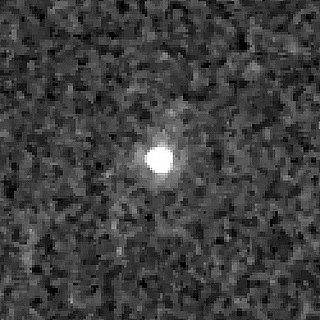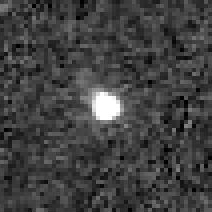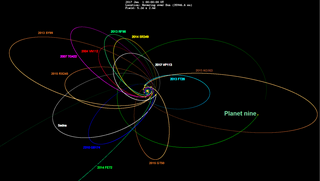Related Research Articles

(208996) 2003 AZ84 (provisional designation 2003 AZ84) is a trans-Neptunian object with a possible moon located in the outer regions of the Solar System. It is approximately 940 kilometers across its longest axis, as it has an elongated shape. It belongs to the plutinos – a group of minor planets named after its largest member Pluto – as it orbits in a 2:3 resonance with Neptune in the Kuiper belt. It is the third-largest known plutino, after Pluto and Orcus. It was discovered on 13 January 2003, by American astronomers Chad Trujillo and Michael Brown during the NEAT survey using the Samuel Oschin telescope at Palomar Observatory.

(42301) 2001 UR163 (provisional designation 2001 UR163) is a resonant trans-Neptunian object and possible dwarf planet located in the outermost region of the Solar System. The object measures approximately 352 kilometers (220 miles) in diameter with a high albedo and stays in an uncommon orbital resonance (4:9) with Neptune. It was discovered on 21 October 2001 by astronomers of the Deep Ecliptic Survey program at Kitt Peak National Observatory near Tucson, Arizona, United States. As of 2021, it has not been named.
(24835) 1995 SM55 (provisional designation 1995 SM55) is a trans-Neptunian object and member of the Haumea family that resides in the Kuiper belt, located in the outermost region of the Solar System. It was discovered on 19 September 1995, by American astronomer Nichole Danzl of the Spacewatch program at Kitt Peak National Observatory near Tucson, Arizona, in the United States. It measures approximately 200 kilometers in diameter and was the second-brightest known object in the Kuiper belt, after Pluto, until 1996 TO66 was discovered.
(79983) 1999 DF9 (provisional designation 1999 DF9) is a trans-Neptunian object of the Kuiper belt, classified as a non-resonant cubewano, that measures approximately 270 kilometers in diameter.
(91205) 1998 US43 (provisional designation 1998 US43) is a resonant trans-Neptunian object of the plutino group, located in the Kuiper belt in the outermost region of the Solar System. The rather bluish body measures approximately 111 kilometers (69 miles) in diameter. It was discovered on 22 October 1998, by American astronomer Marc Buie at the Kitt Peak National Observatory in the United States. It is probably not a dwarf planet candidate.

(40314) 1999 KR16 is a trans-Neptunian object on an eccentric orbit in the outermost region of the Solar System, approximately 254 kilometers (158 miles) in diameter. It was discovered on 16 May 1999, by French astronomer Audrey Delsanti and Oliver Hainaut at ESO's La Silla Observatory in northern Chile. The very reddish object is a dwarf planet candidate and has a rotation period of 11.7 hours.
(469306) 1999 CD158 (provisional designation 1999 CD158) is a trans-Neptunian object from the circumstellar disc of the Kuiper belt, located in the outermost region of the Solar System. The relatively bright hot classical Kuiper belt object measures approximately 310 kilometers (190 miles) in diameter. It was discovered on 10 February 1999, by American astronomers Jane Luu, David Jewitt and Chad Trujillo at Mauna Kea Observatories on the Big Island of Hawaii, United States.
(589683) 2010 RF43 (provisional designation 2010 RF43) is a large trans-Neptunian object orbiting in the scattered disc in the outermost regions of the Solar System. The object was discovered on 9 September 2010, by American astronomers David Rabinowitz, Megan Schwamb and Suzanne Tourtellotte at ESO's La Silla Observatory in northern Chile.
(445473) 2010 VZ98 (provisional designation 2010 VZ98) is a trans-Neptunian object of the scattered disc, orbiting the Sun in the outermost region of the Solar System. It has a diameter of approximately 400 kilometers.
2010 TJ is a trans-Neptunian object from the scattered disc in the outermost region of the Solar System and measures approximately 460 kilometers in diameter. It was first observed by American astronomers David Rabinowitz, Megan Schwamb, and Suzanne Tourtellotte at ESO's La Silla Observatory in northern Chile on 2 October 2010.
2011 FW62, also designated 2015 AJ281, is a magnitude-5.0 trans-Neptunian object that was discovered in 2011. Its orbital elements were very uncertain and it was lost. It was recovered on 6 January 2015 as 2015 AJ281. 2011 FW62 has been identified as a member of the Haumea family in a dynamical study led by Proudfoot and Ragozzine in 2019.
(523645) 2010 VK201 (provisional designation 2010 VK201) is a trans-Neptunian object and member of the classical Kuiper belt, approximately 500 kilometers (310 miles) in diameter. It was discovered on 1 November 2010, by the Pan-STARRS 1 survey at Haleakala Observatory, Hawaii, United States. It has a rotation period of 7.6 hours. It was numbered in September 2018 and remains unnamed.
(78799) 2002 XW93, provisional designation 2002 XW93, is a trans-Neptunian object and centaur from the outer Solar System, approximately 500–600 kilometers (300–400 mi) in diameter. It was discovered on 10 December 2002, by astronomers at the Palomar Observatory in California.

341520 Mors–Somnus, provisional designation 2007 TY430, is a binary and plutino. It consists of two components less than 60 kilometers in diameter, orbiting at a distance of 21000 km.

2015 RX245 is an extreme trans-Neptunian object, detached, on a highly eccentric orbit in the outermost region of the Solar System. It measures approximately 250 kilometers (160 miles) in diameter and is "possibly" a dwarf planet. It was first observed on 8 September 2015, by astronomers with Outer Solar System Origins Survey using the 3.6-meter Canada–France–Hawaii Telescope at Mauna Kea Observatories, Hawaii, in the United States.
(505478) 2013 UT15 is an extreme trans-Neptunian object from the scattered disc, located in the outermost regions of the Solar System, approximately 260 kilometers (160 miles) in diameter. It was discovered on 2 August 2013, by astronomers of the Outer Solar System Origins Survey at Mauna Kea Observatory, Hawaii, United States.
(506479) 2003 HB57, is an extreme trans-Neptunian object of the extended scattered disc in the outermost region of the Solar System, approximately 180 kilometers in diameter. It was discovered by astronomers at the Mauna Kea Observatory on 26 April 2003.

(416400) 2003 UZ117 (provisional designation 2003 UZ117) is a trans-Neptunian object and suspected member of the Haumea family, located in the Kuiper belt in the outermost region of the Solar System. It was discovered on 24 October 2003, by astronomers of the Spacewatch survey project at Kitt Peak Observatory, Arizona. The object may also be a non-resonant cubewano.
(501581) 2014 OB394, provisional designation 2014 OB394, is a trans-Neptunian object from the outermost region of the Solar System, approximately 260 kilometers (160 miles) in diameter. It was discovered on 25 August 2012, by astronomers with the Pan-STARRS survey at Haleakala Observatory, Hawaii, United States. The weak dwarf planet candidate was numbered in 2017 and remains without a name.
(505448) 2013 SA100, provisional designation 2013 SA100 and also known as o3l79, is a trans-Neptunian object from the classical Kuiper belt in the outermost region of the Solar System. It was discovered on 5 August 2013, by astronomer with the Outer Solar System Origins Survey at the Mauna Kea Observatories, Hawaii, in the United States. The classical Kuiper belt object belongs to the hot population and is a weak dwarf planet candidate, approximately 260 kilometers (160 miles) in diameter.
References
- 1 2 3 4 5 "JPL Small-Body Database Browser: 315530 (2008 AP129)" (2023-03-25 last obs.). Jet Propulsion Laboratory . Retrieved 28 June 2023.
- 1 2 3 Johnston, Wm. Robert (15 October 2017). "List of Known Trans-Neptunian Objects". Johnston's Archive. Retrieved 16 November 2017.
- ↑ Marc W. Buie. "Orbit Fit and Astrometric record for 315530". SwRI (Space Science Department). Retrieved 18 February 2018.
- 1 2 3 4 "315530 (2008 AP129)". Minor Planet Center. Retrieved 28 June 2023.
- 1 2 3 4 5 "LCDB Data for (315530)". Asteroid Lightcurve Database (LCDB). Retrieved 9 December 2017.
- 1 2 3 Michael E. Brown. "How many dwarf planets are there in the outer solar system?". California Institute of Technology . Retrieved 30 July 2017.
- 1 2 Thirouin, Audrey; Sheppard, Scott S.; Noll, Keith S.; Moskovitz, Nicholas A.; Ortiz, Jose Luis; Doressoundiram, Alain (June 2016). "Rotational Properties of the Haumea Family Members and Candidates: Short-term Variability". The Astronomical Journal. 151 (6): 20. arXiv: 1603.04406 . Bibcode:2016AJ....151..148T. doi: 10.3847/0004-6256/151/6/148 . S2CID 118510175.
- ↑ Proudfoot, Benjamin; Ragozzine, Darin (May 2019). "Modeling the Formation of the Family of the Dwarf Planet Haumea". The Astronomical Journal. 157 (6): 230. arXiv: 1904.00038 . Bibcode:2019AJ....157..230P. doi: 10.3847/1538-3881/ab19c4 . S2CID 90262136.
- ↑ "MPC/MPO/MPS Archive". Minor Planet Center. Retrieved 25 February 2018.